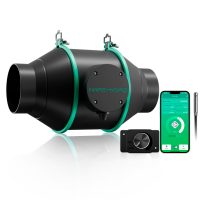Have you ever heard whispers about seed feminization and wondered what all the fuss is about? Let's delve into this popular yet sometimes controversial topic and see if it is the silver bullet we thought it was.
What Is Seed Feminization?

In a nutshell, seed feminization is a technique used in plant breeding, particularly in cultivating crops like cannabis, to produce seeds that have a high probability of developing into female plants.
As we all know, female plants are typically more desirable in cannabis cultivation because they produce cannabinoid-rich flowers, while male plants do not. Using feminized seeds, you can ensure a more consistent crop of female plants, which is vital for maximizing flower production and cannabinoid content.
Besides enhancing yield, feminized seeds eliminate the labor-intensive task of distinguishing and removing male plants. This minimizes the risk of unintentional pollination of females. However, it's crucial to acknowledge that feminized seeds might have an increased chance of hermaphroditism(developing both male and female flowers) due to the stress-related techniques involved in their creation. It's imperative for growers to keep an eye on their feminized plants to spot and address any hermaphroditic tendencies.
If you look forward to optimizing harvests in crops like cannabis, where female plants are a gold mine due to their rich cannabinoid content, learning more details about seed feminization can significantly impact your success and get the most bang for your buck.
Seed Feminization: Not Always a Home Run
Although seed feminization has contributed to crop yield, the unstable genetics in feminized seeds are a risk factor for hermaphroditism, making seed feminization not a surefire guarantee.
In simple terms, despite using advanced methods like colloidal silver sprays or hormonal treatments, some seeds might not stay purely female. Instead, they might develop into plants with dual characteristics.
Why Might Hermaphroditism Occur?
1. Environmental Stress
Environmental conditions such as light stress, temperature, and humidity, especially during the flowering stage, often act as stress factors inducing hermaphroditism.
Light stress : Plants like marijuana are photoperiodic, meaning they respond to light and dark periods. These plants typically require a strict 12/12 light-dark cycle during the flowering stage. If you just use plastic to cover the facility or utilize a cheap grow tent without an updated zipper design, there is a chance of getting light leaks that could stress the plants. Inconsistent light exposure can confuse plants, affecting their sex expression.
Temperature: Cannabis prefers moderate climates. If the temperature is too low, the plants will have slowed growth and smaller yields. When the temperature surpasses their comfort zone, they show signs of discomfort. Their leaves may curl, taking on a claw-like appearance, or might lose their vibrancy, showing symptoms similar to sunburn. Such stress factors could affect internal phytohormone levels, such as gibberellin ratios, which could, in turn, trigger hermaphroditic flower formation in marijuana plants.
Humidity: Humidity can significantly affect how well a plant can photosynthesize. High humidity will increase the risk of mold, especially in the dense floral clusters of female cannabis plants. If plants become infected, they might be more prone to produce hermaphroditic flowers as a stress response. Symptoms of low humidity are similar to low soil moisture or excessive light conditions. It will make the leaves of your plants start to curl downward or inward, then turn brown and crisp.
2. Soil conditions

Soil conditions, including pH balance and watering practices, play a vital role in the overall health and development of plants. These conditions can indirectly influence the occurrence of hermaphroditism in plants by creating stress or imbalances.
PH Balance: Soil pH affects nutrient availability. Even if nutrients are present in the soil, they might not be accessible to plants if the pH is too high or too low. Plants grown in soils with imbalanced pH levels might experience nutrient deficiencies or toxicities, even if fertilization practices are correct. This stress can potentially lead to hermaphroditism.
Watering Practices: Both over and under-watering can stress plants. Over-watering can result in the decay of roots, whereas under-watering can induce dryness-related strain. Water stress can affect the plant's vigor and health, potentially leading to hermaphroditism as the plant tries to reproduce under unfavorable conditions.
3. Insect Pests

Pests like aphids, whiteflies, or caterpillars can cause direct harm to plants by feeding on them. Also, some insect pests are vectors for plant diseases. For instance, aphids can spread plant viruses. Insect damage can induce a defensive response in plants. This response often involves a shift in the internal hormone balance, potentially influencing sexual expression and increasing the likelihood of hermaphroditism.
The Downside of Hermaphroditism
Even though, biologically speaking, hermaphrodite plants can reproduce under less than ideal conditions, which is a beneficial survival mechanism, from the grower's perspective, hermaphroditism can lead to seeded buds, which generally have lower concentrations of cannabinoids and terpenes, resulting in reduced potency and significant economic loss.
What's worse is that hermaphrodite plants not only reduce their own yield but can also pollinate other female plants in the same cultivation area, affecting the overall yield and quality of the entire cultivation system. Moreover, if you don't clean the cultivation area properly after producing hermaphroditic crops, it can affect subsequent crops, leading to significant losses while also increasing cultivation costs.
Tips for Successful Cultivation
Prevention is key. Since the signs of plants receiving stress don't manifest until days or weeks after the original stressor, regular monitoring, early intervention, and the use of integrated pest management (IPM) can help maintain plant health and stability.
The quest for a guaranteed female plants necessitates a deeper understanding and monitoring of the cultivation environment. Implementing smart systems that can record long-term data on plant health, such as environmental and soil conditions, will significantly aid in this endeavor.
By adopting grow tent kits with a smart system, you can preemptively address issues that threaten the feminization process, steering closer to the goal of a male-free crop. This proactive approach will help you obtain a more assured and fruitful cultivation experience.






